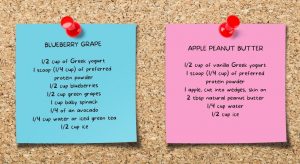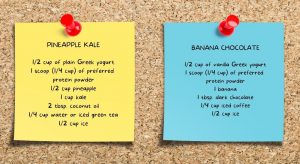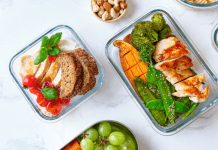:: Disclaimer :: This article was not written by a medical professional. The content is based on the author’s experience and passion for nutrition. Consult with your doctor before making any major changes to your diet and exercise.
You’re a mom. You’re busy. Between responsibilities at home, at work, with the kids, and in the community, you don’t have time to eat — or simply forget. You don’t even realize you’re starving until you’re in the carpool line. A great solution for this hunger is a meal-replacement smoothie.
Meal-replacement smoothies can be quick to make and usually only require a handful of ingredients and a blender. So, if it crosses your mind before you hop in the car on your way to whatever mom duty is driving you today, follow this guide to make a meal-replacement smoothie in minutes.
There is a formula to making a meal-replacement smoothie that will save you from the recipe hunt. Every smoothie can be made with five to six ingredients while being healthy, delicious, and satisfy your hunger.
>> RECOMMENDED RESOURCE :: Spill the Tea :: Guide to Tea Shops & Cafes in North Texas <<

It’s worth noting I need to monitor my sugar intake because I am high-risk for developing diabetes, so I offer some alternative ingredients that are lower in sugar, while still avoiding artificial sweeteners. The chainstore smoothies have a lot of drinks with fruit-juice bases and turbinado sugar, so it is much healthier to make a sugar-conscious smoothie at home.
Why Make a Meal-Replacement Smoothie?
The idea is to prepare yourself a “meal” that will provide all your nutrients in one swoop and also wont leave you hungry 90 minutes later. Whatever flavor smoothie you create, you should feel satiated and energized for four to six hours.
Every meal-replacement smoothie needs to have the following components:
- A base
- A protein source or supplement
- Fruit and/or vegetables
- A healthy fat
The Base
Common bases at your favorite smoothie chains are fruit juices and yogurt. Fruit juices contain a lot of unnecessary calories and sugar, so I recommend going the yogurt route. A heaping 1/2 cup of Greek yogurt is a great base, because it’s a little thicker than standard yogurt and is packed with probiotics for your digestive health. You can choose to use plain Greek yogurt, or if you desire a flavor (I prefer vanilla), make sure the brand you choose uses real sugar and not any artificial sweeteners. If you’re dairy-free, use a plant- or nut-milk yogurt.
If you find using only yogurt as a base is making your smoothie a little too thick, add a 1/4 cup of water and re-blend.
The Protein
The main reason to add a protein to your smoothie is that it’s what upgrades your smoothie from a snack to a meal. The protein is the component that satiates your hunger for a few hours.

There are hundreds of protein powders to choose from, and if you don’t already have a go-to protein supplement, it’s hard to decide on one to try. A lot of protein powders come in single-serving packets, so you can sample and experiment with different types. I recommend visiting a grocery store that has a bulk food section, like Sprouts, Central Market, or WinCo, and getting a pound of unflavored whey protein powder, or a plant protein if you prefer. Add 1 scoop (or 1/4 cup) to your smoothie.
>> RELATED READ :: 8 Tips to Get Kids to Eat Their Veggies <<
There are some protein powders marketed specifically for athletes, which are fine for a smoothie, but they’re designed to accompany exercise and not wholly serve as a meal replacement. If you haven’t or aren’t planning to hit the gym today, a standard whey or plant protein is the better option.
Fruits and Vegetables
Absolutely no fruit and vegetables are off the table here, so go for it! Whatever you prefer for flavor, nutrient, or vitamin purposes is perfect. Here are just a few guidelines when considering the fruits and vegetables you will use:
Fruit is great for flavor, but some fruits are higher in sugar than others. So if you’re minding your sugar intake, fruits lower in sugar are berries, like blueberries, strawberries, etc. Apples are another good option, but make sure you leave on the skins for the nutrients. Citrus fruits are higher in sugar, but are also a healthy source of vitamin C. Bananas are high-sugar fruit (I was surprised by that, too!). However, bananas go great in smoothies and satiate hunger, so I say put that banana in there. And no matter the variety of fruit you use, the target portion size for a single-serving smoothie is 1/2 to 1 1/2 cups of combined fruit.

If you’re shy about using vegetables in your smoothie, here are a few recommendations: Add 1 cup of raw kale or baby spinach to your smoothie. Not for the flavor (because yuck), but for the nutrients found in leafy greens. The other components in your smoothie will mask the flavor of the greens, and the extra body in your smoothie will contribute to its satiability. Some other good vegetables to use for health and sometimes for flavor are carrots and cucumbers.
Healthy Fat
My favorite three healthy fats to add are natural peanut butter, coconut oil, and avocado. Peanut butter (or other nut butters if that’s your preference) are great in smoothies with apples, berries, and bananas. I add coconut oil to more tropical smoothies, like ones with citrus fruit. Avocados can go in any smoothie because its flavor will be diminished by any fruit you choose. A small portion is recommended, about two tablespoons.
Final Tip
Don’t forget to add ice, because smoothies are better cold! The real trick is how and when to add the ice. It’s best to combine all the other ingredients first in a blender, and then add 1/2 cup of ice and reblend until your smoothie has your desired texture.
And if there’s something else you want to throw in there, please do! Some other additions can include, but aren’t limited to:
- cinnamon
- honey
- lemon juice
- flax seeds or chia seeds
- dark chocolate
- ginger
- coffee/tea
- nuts
- rolled oats
Here are four recipes that follow this formula that you might enjoy. Or go have fun creating your own!















